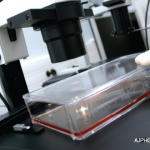
Case: An athletic 19-year-old male has an episode of rhabdomyolysis, a breakdown of muscle tissue that leads to contents of muscle fiber in the blood, after weight-lifting and basketball drills.
Gordon Swanson/shutterstock.com
SAN FRANCISCO—An athletic 19-year-old male has an episode of rhabdomyolysis, a breakdown of muscle tissue that leads to contents of muscle fiber in the blood, after weight-lifting and basketball drills. But his labs come back normal.
He cuts down on his exercise, but has a second episode four months later, then finally sees a rheumatologist seven months after the first problems arose.
He has at-rest creatinine kinase levels ranging from the upper level of normal to more than triple that amount. In a forearm ischemic exercise test (FIET)—a test of the body’s metabolic processes when under relative anaerobic conditions—he shows a normal rise in lactate, but a suboptimal rise in ammonia.
“I know what you’re thinking, and maybe even feeling,” said Kenneth O’Rourke, MD, professor of medicine in the Section on Rheumatology and Immunology at Wake Forest School of Medicine, in a talk on metabolic myopathies during the 2015 ACR/ARHP Annual Meeting. “When this kind of patient presents to the adult rheumatologist in the office with all of these funny lab tests, I think it’s very common that all of us experience some degree of baseline fear.
“The fear, I think, is not unexpected—these are really uncommon diseases,” he added. “Many of them are congenital or seen in pediatrics.” Plus, he said, much of the research on them is not found in the typical rheumatology literature, but in neurology and genetics literature.
But with a little baseline knowledge and a little guidance on what to look for, Dr. O’Rourke said, clinicians can more easily identify metabolic myopathies—genetic disorders involving impaired production of adenosine triphosphate (ATP), the chemical energy currency within cells. Symptoms generally appear symmetrically in the limb-girdle areas, but there are variations, he said.
Myositis Mimics
When a patient comes into the office complaining of muscle problems, the tendency is often to look for inflammatory myositis—including fixed proximal weakness, rash and inflammatory changes on electromyography.
But it’s important to look for clues that indicate that it might not be myositis, Dr. O’Rourke said: weakness tied to exercise, cramping, weakness of an episodic nature, muscle hypertrophy, myotonia and—the main hallmark—no improvement with immunosuppressants.
One mimic is muscle channelopathy. Muscle channelopathies are marked by, among other things, myotonia, or episodic paralysis and weakness. The most common of these is hypokalemic periodic paralysis 1—of the muscle channelopathies, the one most likely to be associated with fixed weakness, as well as attacks that last hours or days, and has an onset when people are in their 20s.

